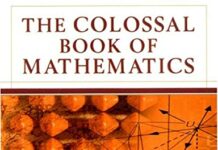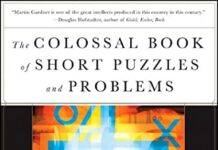
Ebook Info
- Published: 2005
- Number of pages: 168 pages
- Format: PDF
- File Size: 12.91 MB
- Authors: Martin Gardner
Description
This book contains scores of intriguing puzzles and paradoxes from Lewis Carroll, the author of Alice in Wonderland, whose interests ranged from inventing new games like Arithmetical Croquet to important problems in symbolic logic and propositional calculus. Written by Carroll expert and well-known mathematics author Martin Gardner, this tour through Carroll’s inventions is both fun and informative.
User’s Reviews
Reviews from Amazon users which were colected at the time this book was published on the website:
⭐Lewis Carroll was in “real life” Charles Dodgson, lecturer in mathematics at Oxford University and author of books on geometry and logic. Mathematics intrudes into his children’s books, especially Sylvie and Bruno. There is nobody better qualified to explain this side of Lewis Carroll to the non-mathematician than Martin Gardner, author of the Annotated Alice and for many years the compiler of the Mathematical Puzzles column in Scientific American. This book will delight Carroll’s many fans and may intrigue many who would not normally be attracted to children’s fiction. I also recommend the two books on Lewis Carroll’s puzzles by Edward Wakeling; as a professional mathematician, he brings a complementary perspective.
⭐Quite an interesting book of puzzles. If you like Martin Gardner (and who doesn’t) this is an excellent book based on Lewis Carroll’s brilliant mind.
⭐I use this book as the basis for an honors project for my high school Geometry class. I teach a lesson about Lewis Carroll and his various logic puzzles and word ladders. This book is an excellent source for research and other games/puzzles to use with my students.
⭐We have Martin Gardner to thank for his efforts in explaining about the author everyone knows as the author of what they think is a Children’s book.Known as Lewis Carroll,the author’s real name was Charles Lutwidge Dobson was a competent mathematician and taught mathematics at Christ Church,Oxford. He had a strong sense of mathematical beauty and entertained many in expressing this fondness in mathematical games,puzzles,logic, paradoxes,magic tricks,riddles,and every variety of word play,especially word games puns,anagrams,anagrams,and acrostic verse;all published under the name of Lewis Carroll.Two of his best known books,”Alice’s Adventures in Wonderland” and “Through the Looking Glass” are filled ,though somewhat hidden,with puzzles,paradoxes,word play,etc.Words,numbers,games entertained Carroll and those around him throughout his life. Gardner’s book brings all this out to us and shows why he was such an important figure in the world of Mathematical Recreations and as well as other forms of entertainment and games.One of Carroll’s favorite pursuits was what is called Doublets.Most people who like word games of various types will be familiar with these.The object is to take a word such as COLD and by changing one letter at a time,making different words ,ending up with the word WARM.The real challenge is to do this in the least number of steps.Thus we have COLD,CORD,CARD,WARM.–4 steps.This can lead to all kinds of interesting posers.Carroll,actually a skeptic of Darwin’s theory,”evolved” MAN from APE in six steps: APE,ARE,ERE,ERR,EAR,MAR,MAN. Another interesting poser is to change IRON into LEAD: IRON,ICON,COIN,CORN,CORD,LORD,LOAD,LEAD. Another of Carroll’s interest was Mazes and we are given a very interesting Maze Carroll created in his early twenties.Another of his puzzles ,called river-crossing puzzles is given.This type of puzzle has been presented by many other puzzlers over the years. Even if you’ve never been interested in numbers as such you will be fascinated with ; A Magic Number 142857 85714 twice that number, 428571 trice that number 571428 four times that number, 714285 five times that number, 857142 six times that number Begin at the “1” in each line and it will be the same order of figures as the magic number up to six times that number,while seven times the magic number results in a row of 9’s. If you have any interest or fascination with numbers,words games of various types;you’ll be amazed at what interesting things came from the man who wrote a book generally assumed to be a Children’s book.
⭐Ok, since there is some confusion on the issue, let me explain how the 2/3 comes about. We are looking for the probability that the second marble is white, given that the first one pulled out of the bag was.First intuitively – if you think about it, if there had been 2 white marbles in the bag to start with you’re more likely to have pulled out a white marble on the first draw than you would have if the bag started with one white and one black. That is, knowing that you pulled out a white marble, it’s more likely that both marbles were white than it is that there was one of each.Now mathematically – this is called conditional probability. Because of the problem description, before drawing the bag could either contain one of each color or two white marbles, each of these options with probability .5 (50%). If the bag has one of each, your probability of drawing white first is .5, and if it has two whites your probability of drawing white first is 1 (100%).So, the (compound) probability that the bag has one of each *and* you get white first is .5 x .5 = .25 and the probability that the bag has both white and you get white first is .5 x 1 = .5. So, the total probability of getting white first is the sum of the probabilities of these two possible ways of that occuring, .75.Now, the actual probability that was requested was that of there being a white marble in the bag after taking out a white one…that is, what’s the probability of the bag having had 2 white marbles if you know it had at least one. This should be the same as the probability of getting two white marbles divided by the probability that the first marble was white.Probability notation for this conditional probability isP(W2|W1) = P(W1 & W2)/P(W2)Which then is .5/.75, which is equal to 2/3 – the number given in the editorial. The result does maybe initially seem to be a strange number, but there is no wiggle room here. It’s correct.
Keywords
Free Download The Universe in a Handkerchief: Lewis Carroll’s Mathematical Recreations, Games, Puzzles, and Word Plays in PDF format
The Universe in a Handkerchief: Lewis Carroll’s Mathematical Recreations, Games, Puzzles, and Word Plays PDF Free Download
Download The Universe in a Handkerchief: Lewis Carroll’s Mathematical Recreations, Games, Puzzles, and Word Plays 2005 PDF Free
The Universe in a Handkerchief: Lewis Carroll’s Mathematical Recreations, Games, Puzzles, and Word Plays 2005 PDF Free Download
Download The Universe in a Handkerchief: Lewis Carroll’s Mathematical Recreations, Games, Puzzles, and Word Plays PDF
Free Download Ebook The Universe in a Handkerchief: Lewis Carroll’s Mathematical Recreations, Games, Puzzles, and Word Plays

